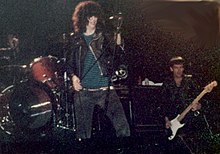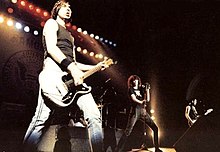Ramones
[37] Punk, which was largely responsible for codifying the term for the scene emerging around CBGB, ran a cover story on the Ramones in its third issue, the same month as the album's release.
[44] It was not until they made a brief tour of England that they began to see the fruits of their labor; a performance at the Roundhouse in London on July 4, 1976, with The Stranglers supporting the Flamin' Groovies, organized by Linda Stein, was a resounding success.
[46][47] Their Roundhouse appearance and a club date the following night—where the band met members of the Sex Pistols and the Clash—helped galvanize the burgeoning UK punk rock scene.
Leave Home also included a fast-paced cover of the oldie "California Sun", written by Henry Glover & Morris Levy, and originally recorded by Joe Jones,[50] though the Ramones based their version on the remake by the Rivieras.
On December 31, 1977, the Ramones recorded It's Alive, a live concert double album, at the Rainbow Theatre, London, which was released in April 1979 (the title is a reference to the 1974 horror film of the same name).
His position as drummer was filled by Marc Bell, who had been a member of the early 1970s hard rock band Dust, Wayne County,[54] and the pioneering punk group Richard Hell & the Voidoids.
As described by Trouser Press, the album, produced by Graham Gouldman of UK pop act 10cc, moved the Ramones "away from their pioneering minimalism into heavy metal territory".
[65] According to Trouser Press, it brought the band "back to where they once belonged: junky '60s pop adjusted for current tastes", which among other things meant "easing off the breakneck rhythm that was once Ramones dogma.
"[72] Richie was also the only drummer to be the sole composer of Ramones songs including their hit "Somebody Put Something in My Drink" as well as "Smash You", "Humankind", "I'm Not Jesus", "I Know Better Now" and "(You) Can't Say Anything Nice".
[77] The song was written, primarily by Joey, in protest of Ronald Reagan's visit to a German military cemetery, which included graves of Waffen SS soldiers.
[79] Making it his pick for "album of the week", New York Times critic Jon Pareles wrote that the Ramones "speak up for outcasts and disturbed individuals".
Richie left in August 1987 after financial conflicts with Johnny that centered around him being refused a small percentage of the merchandising money, which had been requested based on his tenure with the band and their use of his name and image.
[22] In December 1988, the Ramones recorded material for their eleventh studio album, and what was originally intended to be a "comeback" for the band,[83][84] Brain Drain was co-produced by Beauvoir, Rey, and Bill Laswell.
Green Day played "Teenage Lobotomy", "Rockaway Beach", and "Blitzkrieg Bop" as a tribute, demonstrating the Ramones' continuing influence on later rock musicians.
[127] The tensions among the group members were not kept secret from the public as was heard on the Howard Stern radio show in 1997, where during the interview Marky and Joey got into a fight about their respective drinking habits.
[131] Many years later, C. J. lamented that despite being the two surviving members of arguably the Ramones' most commercially successful era, and despite reaching out a few times to join him on stage, he and Marky were no longer in contact.
[132] The Ramones' loud, fast, straightforward musical style was influenced by pop music that the band members grew up listening to in the 1950s and 1960s, including classic rock groups such as Buddy Holly and the Crickets, the Beach Boys, the Who, the Beatles, the Kinks, Led Zeppelin, the Rolling Stones, the Doors and Creedence Clearwater Revival; bubblegum acts like the 1910 Fruitgum Company and Ohio Express; and girl groups such as the Ronettes and the Shangri-Las.
"[135] Ira Robbins and Scott Isler of Trouser Press describe the result: With just four chords and one manic tempo, New York's Ramones blasted open the clogged arteries of mid-'70s rock, reanimating the music.
Johnny's instructions to C. J. when preparing for his first live performances with the group were to play facing the audience, to stand with the bass slung low between spread legs, and to walk forward to the front of stage at the same time as he did.
[145] He produced the band's T-shirts—their main source of income—basing most of the images on a black-and-white self-portrait photograph he had taken of his American bald eagle belt buckle, which appeared on the back sleeve of the Ramones' first album.
I thought, 'The Great Seal of the President of the United States' would be perfect for the Ramones, with the eagle holding arrows—to symbolize strength and the aggression that would be used against whomever dares to attack us—and an olive branch, offered to those who want to be friendly.
"[150] Trouser Press's Robbins and Isler similarly wrote that the Ramones "not only spearheaded the original new wave/punk movement, but also drew the blueprint for subsequent hardcore punk bands".
[136] Punk journalist Phil Strongman writes, "In purely musical terms, the Ramones, in attempting to re-create the excitement of pre-Dolby rock, were to cast a huge shadow—they had fused a blueprint for much of the indie future.
"[157] The Ramones' two July 1976 shows, like their debut album, are seen as having a significant impact on the style of many of the newly formed British punk acts—as one observer put it, "instantly nearly every band speeded up".
[162] Ramones concerts and recordings influenced many musicians central to the development of California punk, including Greg Ginn of Black Flag,[163] Jello Biafra and East Bay Ray of the Dead Kennedys,[164][165] Mike Ness of Social Distortion,[166] Brett Gurewitz of Bad Religion,[167] and members of the Descendents.
The Song Ramones the Same, which came out the following year, includes performances by the Dictators, who were part of the early New York punk scene, and Wayne Kramer, guitarist for the influential protopunk band MC5.
We're a Happy Family: A Tribute to Ramones, released in 2003, features performers such as Rancid, Green Day, Metallica, KISS, the Offspring, Red Hot Chili Peppers, U2, and Rob Zombie (who also did the album cover artwork).
Motörhead's Phil Campbell tells in Jari-Pekka Laitio-Ramone's book Ramones: Soundtrack Of Our Lives: "We did a cover of Rockaway Beach with me on backing vocals, which was quite enjoyable.
"[192] Punk bands such as Screeching Weasel, the Vindictives, the Queers, Parasites, the Mr. T Experience, Boris the Sprinkler, Beatnik Termites, Tip Toppers, Jon Cougar Concentration Camp, and McRackins have recorded cover versions of entire Ramones albums—Ramones, Leave Home, Rocket to Russia, It's Alive, Road to Ruin, End of the Century, Pleasant Dreams, Subterranean Jungle, two versions of Too Tough to Die, and Halfway To Sanity, respectively.
[194] Shonen Knife, an all-female trio from Osaka, Japan, was formed in 1981 as a direct result of founder-lead singer-guitarist Naoko Yamano's instant infatuation with the music of the Ramones.






